You are using an out of date browser. It may not display this or other websites correctly.
You should upgrade or use an alternative browser.
You should upgrade or use an alternative browser.
Making a ifting roof on a 110
- Thread starter wuntenn
- Start date
Arjan
Fossil Overlander
Yes..
The planning is to do a "UK Raid" in November, via Somerset, going somewhat North.
North, as in : Durness area.
Not sure on routes etc. yet - although not a lot of choice there (...) - but I need to visit several people and work some Gundogs so we're having a ball trying to make it all come together without spending weeks there.
The planning is to do a "UK Raid" in November, via Somerset, going somewhat North.
North, as in : Durness area.
Not sure on routes etc. yet - although not a lot of choice there (...) - but I need to visit several people and work some Gundogs so we're having a ball trying to make it all come together without spending weeks there.
Update and problem solving
Well the lifting roof has proved itself. Been out in a variety of weather and its been light and airy with the sides open in the summer, and survived a reasonably stiff gale one night in the early spring. It's not leaked either, neither when elevated, nor when down and driving into serious amounts of Scottish rain.
The only real problem has been the suspension. The AirLift bags I chose to allow variation in ride dependent on load I was carrying have been excellent - perfect for the job I need them to do. But. But due to a design defect (which AirLift are aware of and working on a fix for) the top rubber retainers that fit inside the upper portion of the rear coil are able to migrate up and distort sufficiently to come through the hole in the spring hanger. Under extreme load they could conceivably pop right through (although I've not had this happen) or rotate, in either case most likely destroying the airline and releasing the pressure.
It could prove awkward to say the least if cornering under load without realizing your rear suspension was not as you expected. The supplier informed me that AirLift are working on a fix but had no idea when this might appear. So I decided to make my own. SO this might help anyone who is faced with a similar problem.
This is the problem - the rubber plug gets pushed up out of the hole in the top of the spring hanger.
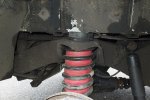
I cut the top shoulders off the rubber plug to leave a square (only square because I was going to try a different method to solve the problem but realized it would not work).
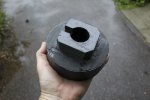
Got a pair of the metal top spring retainers for the helper springs (110/130 flavour) Land Rover Genuine Part No RRC3352.
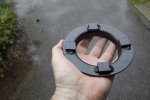
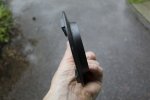
These are good because they have the locating lugs on the upside to fit into the hole above the spring.

Then a cheap 86mm diameter holesaw to drop a slot into the top of the rubber plug - this is to accept the flanged edge of the spring retainer.
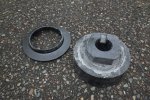
Once the slot was deep enough I used a Bosch oscillating tool to trim off some of the rubber to accommodate the rolled edge of the flange of the spring plate and allow it to sit almost flat on the rubber plug. I realized when I was doing this that the oscillating tool would most likely have done the job of the holesaw although not as neatly, and saved £8.
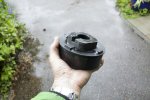
Then fitted this combination into the top of the main coil and held it in place while I fastened on the AirLift bags air hose and refitted all the bits. A combination of lifting the axle and raising/lowering the body had it seated first time each side, with the locating tabs keeping the metal plate central.
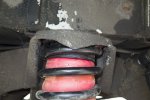
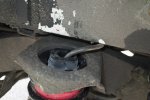
I think the original design of the rubber plugs is intended to fit a bit higher but I kept them lower in the space to ensure that when the axle is articulated a lot the air bags will hold the plug and metal plate up tightly. I'll see how it fares over the summer - my only concern is the lack of any fastening for the metal plate- - in its 'proper' role as a helper spring retainer it is under pressure ALL the time because of the extra length the helper springs are compared to the main springs. Possibly a hole drilled in the metal plate and a hook over the top of the spring might be enough - will consider options if it turns out they're needed.
SO there you go - a fix of sorts for a problem that AirLift are still working on - theirs might be more elegant - but at least mine is at the test pilot stage!
Well the lifting roof has proved itself. Been out in a variety of weather and its been light and airy with the sides open in the summer, and survived a reasonably stiff gale one night in the early spring. It's not leaked either, neither when elevated, nor when down and driving into serious amounts of Scottish rain.
The only real problem has been the suspension. The AirLift bags I chose to allow variation in ride dependent on load I was carrying have been excellent - perfect for the job I need them to do. But. But due to a design defect (which AirLift are aware of and working on a fix for) the top rubber retainers that fit inside the upper portion of the rear coil are able to migrate up and distort sufficiently to come through the hole in the spring hanger. Under extreme load they could conceivably pop right through (although I've not had this happen) or rotate, in either case most likely destroying the airline and releasing the pressure.
It could prove awkward to say the least if cornering under load without realizing your rear suspension was not as you expected. The supplier informed me that AirLift are working on a fix but had no idea when this might appear. So I decided to make my own. SO this might help anyone who is faced with a similar problem.
This is the problem - the rubber plug gets pushed up out of the hole in the top of the spring hanger.

I cut the top shoulders off the rubber plug to leave a square (only square because I was going to try a different method to solve the problem but realized it would not work).

Got a pair of the metal top spring retainers for the helper springs (110/130 flavour) Land Rover Genuine Part No RRC3352.


These are good because they have the locating lugs on the upside to fit into the hole above the spring.

Then a cheap 86mm diameter holesaw to drop a slot into the top of the rubber plug - this is to accept the flanged edge of the spring retainer.

Once the slot was deep enough I used a Bosch oscillating tool to trim off some of the rubber to accommodate the rolled edge of the flange of the spring plate and allow it to sit almost flat on the rubber plug. I realized when I was doing this that the oscillating tool would most likely have done the job of the holesaw although not as neatly, and saved £8.

Then fitted this combination into the top of the main coil and held it in place while I fastened on the AirLift bags air hose and refitted all the bits. A combination of lifting the axle and raising/lowering the body had it seated first time each side, with the locating tabs keeping the metal plate central.


I think the original design of the rubber plugs is intended to fit a bit higher but I kept them lower in the space to ensure that when the axle is articulated a lot the air bags will hold the plug and metal plate up tightly. I'll see how it fares over the summer - my only concern is the lack of any fastening for the metal plate- - in its 'proper' role as a helper spring retainer it is under pressure ALL the time because of the extra length the helper springs are compared to the main springs. Possibly a hole drilled in the metal plate and a hook over the top of the spring might be enough - will consider options if it turns out they're needed.
SO there you go - a fix of sorts for a problem that AirLift are still working on - theirs might be more elegant - but at least mine is at the test pilot stage!
piratexpress1369a
Explorer
Great fix
The Rover Shop
Explorer
Funnily enough I had the same problem of the flange pushing through and I used the same helper spring plate to temporarily solve the issue, in the end I found that I hadn't been supplied the expedition rear springs that I had ordered, put the correct springs in and didn't need the air bags..
Resurrecting this thread for anyone interested in 'evolution! The lifting roof I built has been great - I found an add-on rear tent thats been good to use with it and we've used it as a family with great success. However in marginal conditions - bearing in mind I live beyond 56°N latitude (same as Hudson Bay and Kodiak Island) - when the weather is rough or in winter the lifting roof can be less than practical. When the temp is low you can get condensation forming on the inside, and when the wind blows its very noisy, and 'flicks' the condensation off onto the inside (and your sleeping bag) and my son has had a few terrified nights when he thought it would blow away when we were in bed at 2am and a gale sprang up.
So....I pondered options such as a set of external covers made from truckside material with insulation - very bulky to store and pig to fasten on. Temporary hard sides I can fasten on when the roof is up - too hard to store and an even bigger pain to fit. Internal panels that would fit behind the fabric - hard to store and install on the inside.
Then I thought - the solution might be hard sides with insulation and windows bolted to the existing roof and coming down to the 'waist' of the 110. As I mulled this over I met a Swiss couple in Scotland with their home-made hard sided lifting roof camper and that determined for me it was doable!


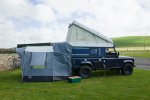
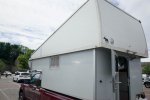
What are the problems this creates?
Back door - how does it open?
Sealing it - in the open and closed positions so wet is kept out when parked and driving?
Weight - will it be too heavy?
Lifting it - how wil I get it up with the additional weight?
Cost?
I made a few mock ups using cardboard scale models, and some computer drawings and it looked feasible.
So I bit the bullet and bought some 19mm box alloy and have set to in earnest. Stay tuned for slow progress as I work my through this journey into the unknown! As before I have no workshop so will be doing all of the work outside on the drive. I DO have a good friend who runs an alloy welding and fabrication business so the main alloy welding and folding will be done by him, and Ill do anything involving steel. For the alloy I'll find ways to jig stuff up and then cart it down to his shop and he'll weld it or fold it for me.
The drawings at top should give you some idea of where this idea will hopefully be heading....
So....I pondered options such as a set of external covers made from truckside material with insulation - very bulky to store and pig to fasten on. Temporary hard sides I can fasten on when the roof is up - too hard to store and an even bigger pain to fit. Internal panels that would fit behind the fabric - hard to store and install on the inside.
Then I thought - the solution might be hard sides with insulation and windows bolted to the existing roof and coming down to the 'waist' of the 110. As I mulled this over I met a Swiss couple in Scotland with their home-made hard sided lifting roof camper and that determined for me it was doable!




What are the problems this creates?
Back door - how does it open?
Sealing it - in the open and closed positions so wet is kept out when parked and driving?
Weight - will it be too heavy?
Lifting it - how wil I get it up with the additional weight?
Cost?
I made a few mock ups using cardboard scale models, and some computer drawings and it looked feasible.
So I bit the bullet and bought some 19mm box alloy and have set to in earnest. Stay tuned for slow progress as I work my through this journey into the unknown! As before I have no workshop so will be doing all of the work outside on the drive. I DO have a good friend who runs an alloy welding and fabrication business so the main alloy welding and folding will be done by him, and Ill do anything involving steel. For the alloy I'll find ways to jig stuff up and then cart it down to his shop and he'll weld it or fold it for me.
The drawings at top should give you some idea of where this idea will hopefully be heading....
Backroad Explorer
Adventurer
Can hardly wait for this New Build!!
Pics of the cardboard models Please.
Pics of the cardboard models Please.
Well Brian the cardboard proved less useful than simple paper! So I ended up with this instead, which was made by taking a photo of the 110 side on and then tracing it on the computer screen (I could see the screen through the white paper!) with key points marked to establish accurate measurments:
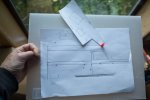
Problems to overcome: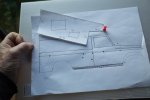
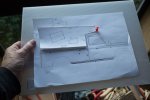
Existing LR back door - how does it open?* Decided that the lifting roof assembly should have a back door in it, slightly wider/taller than the existing door. This will be top hung and with gas struts will be able to be lifted (when roof is in lowered position) and easily access existing back door to get inside the back. It should also be able to be opened when the roof is lifted to the up position to allow big views and lots of fresh air when the conditions allow.
*Problem this creates: spare wheel carrier will be in the way. Solution: make wheel carrier 'swing-away' and mount it on brackets to move it a few inches rearwards to allow the lifting section to come down behind the spare wheel.
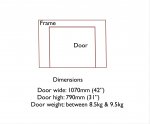
Sealing it - how to do this in both the open and closed positions so wet is kept out when parked and driving? The long diagonal line on the mock up drawing going from top front to lower rear is a crucial aspect. Everything above that line is 'inside' when roof is lifted so needs to be kept dry/clean. Everything below it is 'external' when roof lifted so can get damp. I had a choice here - make the lifting section same as the Swiss version in pic in previous tweet. That creates problems as I have side windows and cargo track each side that will get in the way, and hard to seal. Solution: make the lifting section more like a flatbed camper with its frame come down to the mid section of the 110 and be able to seal it along that line horizontally, and up the side of the door vertically and then above the door horizontally. So in effect everything below that horizontal line is 'redundant' it does not do anything in the lifted position and exists only to allow the whole thing to seal when lowered and driving. Weight penalty to do this was minimal so that was my route.
So the diagonal when in the lowered position acts as an internal weather 'stop' for anything that might blow in, and when lifted sits parallel with the lower section of the existing roof and allows a seal to be made to keep the interior draught free*. (more on this later as this is a crucial aspect to consider)
I decided to use asymmetrical Z section material to form the door frame inner/outer
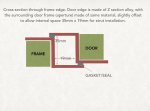
Weight - will it be too heavy? Existing roof is just on the limit of comfortable lifting for me so the added section will be a bit much to safely lift (and I'm over 60 and not getting younger!). However even with new additions it is still not destabilising the vehicle as the weight is carried evenly along the length and down the sides and is still within safe operating limits.
Lifting it: - so how will I get it up with the additional weight? 12V heavy duty Linear Actuators. I found company that can supply very long actuators with a sync box to control the operation ensuring accurate and consistent lifting. These can provide 175lbs push each and are 1M long.
One major issue: the existing lifting roof can open as high as is practically needed, however the addition of hard sides means I am limited to lifting it only as far up as the distance to the 'waist' of the 110. This ,means reducing the interior lifting height by approximately 6 inches. I did some experimenting and it still allows me (6 foot tall) to easily stand up and move through inside the back, and when in sleeping mode with internal bed platform extended I can still get up and although 'cosier' will be fine for sleeping in comfort. Also becasue the roof goes through an arc the lowered 'shapoe' needs to have a slopiong rear angle to allow the back end to be in the vertical plane when lifted.
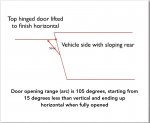
Cost? Alloy material is reasonable, a couple of sheets of 1.2mm alloy, several lengths of 19mm box, thin plywood & insulation and some method of fastening the sides onto the existing roof - I decided on heavier gauge U channel inverted and bolted to the sides of the lifting roof. Only real significant cost is the actuators which will be £500+ and some kind of windows. So I figured about £1200 in total or roughly $1500 all in.

Problems to overcome:


Existing LR back door - how does it open?* Decided that the lifting roof assembly should have a back door in it, slightly wider/taller than the existing door. This will be top hung and with gas struts will be able to be lifted (when roof is in lowered position) and easily access existing back door to get inside the back. It should also be able to be opened when the roof is lifted to the up position to allow big views and lots of fresh air when the conditions allow.
*Problem this creates: spare wheel carrier will be in the way. Solution: make wheel carrier 'swing-away' and mount it on brackets to move it a few inches rearwards to allow the lifting section to come down behind the spare wheel.

Sealing it - how to do this in both the open and closed positions so wet is kept out when parked and driving? The long diagonal line on the mock up drawing going from top front to lower rear is a crucial aspect. Everything above that line is 'inside' when roof is lifted so needs to be kept dry/clean. Everything below it is 'external' when roof lifted so can get damp. I had a choice here - make the lifting section same as the Swiss version in pic in previous tweet. That creates problems as I have side windows and cargo track each side that will get in the way, and hard to seal. Solution: make the lifting section more like a flatbed camper with its frame come down to the mid section of the 110 and be able to seal it along that line horizontally, and up the side of the door vertically and then above the door horizontally. So in effect everything below that horizontal line is 'redundant' it does not do anything in the lifted position and exists only to allow the whole thing to seal when lowered and driving. Weight penalty to do this was minimal so that was my route.
So the diagonal when in the lowered position acts as an internal weather 'stop' for anything that might blow in, and when lifted sits parallel with the lower section of the existing roof and allows a seal to be made to keep the interior draught free*. (more on this later as this is a crucial aspect to consider)
I decided to use asymmetrical Z section material to form the door frame inner/outer

Weight - will it be too heavy? Existing roof is just on the limit of comfortable lifting for me so the added section will be a bit much to safely lift (and I'm over 60 and not getting younger!). However even with new additions it is still not destabilising the vehicle as the weight is carried evenly along the length and down the sides and is still within safe operating limits.
Lifting it: - so how will I get it up with the additional weight? 12V heavy duty Linear Actuators. I found company that can supply very long actuators with a sync box to control the operation ensuring accurate and consistent lifting. These can provide 175lbs push each and are 1M long.
One major issue: the existing lifting roof can open as high as is practically needed, however the addition of hard sides means I am limited to lifting it only as far up as the distance to the 'waist' of the 110. This ,means reducing the interior lifting height by approximately 6 inches. I did some experimenting and it still allows me (6 foot tall) to easily stand up and move through inside the back, and when in sleeping mode with internal bed platform extended I can still get up and although 'cosier' will be fine for sleeping in comfort. Also becasue the roof goes through an arc the lowered 'shapoe' needs to have a slopiong rear angle to allow the back end to be in the vertical plane when lifted.

Cost? Alloy material is reasonable, a couple of sheets of 1.2mm alloy, several lengths of 19mm box, thin plywood & insulation and some method of fastening the sides onto the existing roof - I decided on heavier gauge U channel inverted and bolted to the sides of the lifting roof. Only real significant cost is the actuators which will be £500+ and some kind of windows. So I figured about £1200 in total or roughly $1500 all in.
